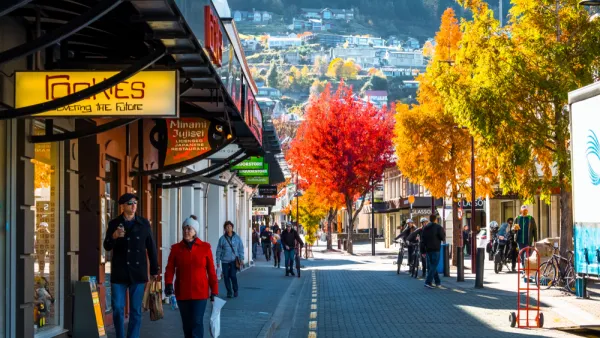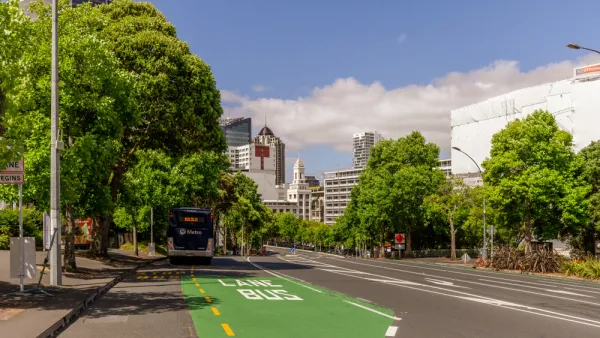An innovate plan to reconceive Auckland's transit network from the ground up led by Jarrett Walker demonstrates the dramatic efficiencies that can be gained, without additional cost, by increasing transfers.
In a new post on his Human Transit blog, Walker discusses the simple geometries behind the ambitious redesign of Auckland's public transit network that he's authored with planners from Auckland Transport and his colleagues at MRCagney.
For the same operating costs as the city's existing network, Walker's proposed plan, "defines an extensive network of high frequency
services around which future urban growth can organize to ensure that
over time, more and more of the city finds public transport convenient." Images of the existing network and the proposed plan demonstrate the dramatic expansion of access.
"What's the catch?", asks Walker. "Only the geometrically inevitable one:
more people will have to make connections from one service to another,
and the fare system will need to encourage rather than penalise that."
"Networks that are designed to prevent transferring must run
massive volumes of half-empty and quarter-empty buses and still have
trouble delivering frequencies that make the service worth waiting for.
The waste involved can be colossal, as you can see from the amount of
service we were able to redeploy in more useful ways with this redesign."
FULL STORY: auckland: how network redesign can transform a city's possibilities

National Parks Layoffs Will Cause Communities to Lose Billions
Thousands of essential park workers were laid off this week, just before the busy spring break season.

Retro-silient?: America’s First “Eco-burb,” The Woodlands Turns 50
A master-planned community north of Houston offers lessons on green infrastructure and resilient design, but falls short of its founder’s lofty affordability and walkability goals.

Delivering for America Plan Will Downgrade Mail Service in at Least 49.5 Percent of Zip Codes
Republican and Democrat lawmakers criticize the plan for its disproportionate negative impact on rural communities.

Test News Post 1
This is a summary

Test News Headline 46
Test for the image on the front page.

Balancing Bombs and Butterflies: How the National Guard Protects a Rare Species
The National Guard at Fort Indiantown Gap uses GIS technology and land management strategies to balance military training with conservation efforts, ensuring the survival of the rare eastern regal fritillary butterfly.
Urban Design for Planners 1: Software Tools
This six-course series explores essential urban design concepts using open source software and equips planners with the tools they need to participate fully in the urban design process.
Planning for Universal Design
Learn the tools for implementing Universal Design in planning regulations.
EMC Planning Group, Inc.
Planetizen
Planetizen
Mpact (formerly Rail~Volution)
Great Falls Development Authority, Inc.
HUDs Office of Policy Development and Research
NYU Wagner Graduate School of Public Service




























